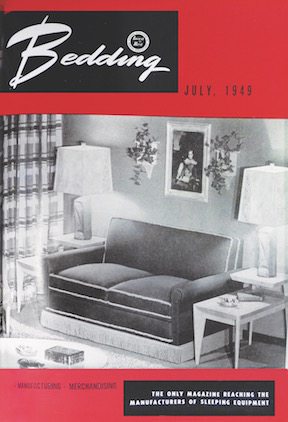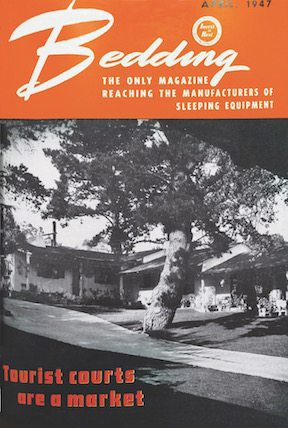Part IV of the second installment on the International Sleep Products Association’s first 100 years
Dual-purpose sleep equipment shares center stage with mattress sets

Sofa beds grew in popularity during the mid-20th century, as did motels—known then as tourist courts.
BY JULIE A. PALM
Day beds. Sofa sleepers. Bed divans. Sofa beds. During this era, many bedding makers put as much energy into producing dual-purpose bedding as mattress sets.
“To be fully prepared for hospitality emergencies, every home should be equipped with at least one modern studio couch or sofa bed. Then let that unexpected guest come when he may. You’ll be ready.” So preached one of many “bedding talks” written and distributed to radio stations by the National Association of Bedding Manufacturers during the early 1940s.
The Estee Bedding Co. of Chicago introduced a sofa bed with latex cushioning during that city’s summer furniture market in 1940 and priced it at $29.95 retail; by 1946, Superior Sleeprite Corp. had introduced at market a love seat that opened into a full-size bed with innerspring mattress for $159 retail. By the mid-1950s, manufacturers were putting as much emphasis on the styling of the dual-purpose products as functionality.

Because of the proliferation and evolution of double-duty products, there was significant confusion among consumers about what differentiated, say a “bed davenport” from a “studio couch.” Francis Seng, president of the Seng Co., editorialized on the subject in the April 1949 issue of Bedding: “There has been a growing tendency among manufacturers, retailers, consumers, and editors and writers to ignore the proper designations of dual-purpose sleeping equipment. … If this habit of miscalling merchandise is continued … it could lead to trouble”—with everyone from the Better Business Bureau to frustrated customers.
In April 1960, the editors of Bedding redesigned the magazine’s cover. A prominent new component was a tag line that, for the first time, highlighted the importance of double-duty products to the industry: “Exclusively Devoted to Manufacturers of Bedding and Dual Purpose Sleeping Equipment.” The category remained significant through the decade.
Some other notable product trends during the era:
✦ Metal beds and open metal springs dropped off in popularity, likely because they were largely unavailable during World War II. Box springs, on the other hand, became increasingly commonplace.
✦ Latex arrived on the U.S. bedding scene in the late 1930s and only grew in popularity in this later era. Polyurethanes—praised for their quick recovery time and light weight, among other qualities—challenged latex for a place in bedding during the mid-1950s. (One of Spring Air’s early polyurethane models retailed for $89.50 in 1960.)
✦ A new market opened up with the proliferation of motels, or “tourist courts” as they were sometimes called early on. By 1947, there were more than 20,000 motels in the nation. A survey conducted by Trailer Court Journal and republished in Bedding magazine in April 1947 indicated the typical motel had an average of 27 beds and half of facility owners planned to replace at least some of those beds in the coming year.
✦ Longtime standard components got updates. For instance, curled hair, a staple of mattresses in the 1920s and 1930s, got rubberized during this period.
Read all seven parts of this month’s special ISPA 1941-1965 centennial section:
Part I – A time of war, a time for peace
Part II – Promoting better sleep
Part III – Mattress makers introduce ‘king’ and ‘queen’ sizes
Part IV – Mattress industry introduces the sofa bed
Part V – NABM introduces magazine exclusively for bedding retailers
Part VI – Mattress components makers ‘integral’ to industry
Part VII – ‘Do Not Remove This Tag Under Penalty of Law’




